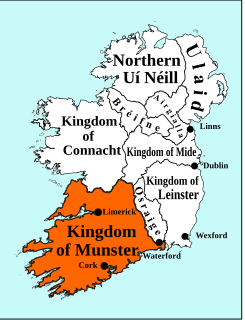Coirpre Luachra mac Cuirc (flourished mid 5th century) was the ancestor of the Eóganacht Locha Léin branch of the Eoganachta, the ruling dynasty of Munster. This branch was also called the Ui Caipre Luachra, named after him and became the rulers of Iarmuman (West Munster). He was the son of Conall Corc mac Luigthig, founder of the Eoganachta kingdom of Cashel in Munster. [1]
An ancestor is a parent or (recursively) the parent of an antecedent. Ancestor is "any person from whom one is descended. In law the person from whom an estate has been inherited."
Eóganacht Locha Léin or Ui Caipre Luachra were a branch of the ruling Eoganachta of Munster. Their territory was in Iarmuman or West Munster. Luachair (Lúachra) is the old name of a large district on the borders of Co Cork, Kerry and Limerick. Cairbre of Sliobh Luachra was on the Cork-Kerry border; Éoganacht Locha Lein is around the Lakes of Killarney.

A dynasty is a sequence of rulers from the same family, usually in the context of a feudal or monarchical system, but sometimes also appearing in elective republics. Alternative terms for "dynasty" may include "house", "family" and "clan", among others. The longest-surviving dynasty in the world is the Imperial House of Japan, otherwise known as the Yamato dynasty, whose reign is traditionally dated to 660 BC.
Contents
Coirpre is mentioned in genealogical tracts of the Eoganachta. According to these tracts he was the son of Conall Corc by Mongfind daughter of Feredach, King of the Picts of Scotland. Hence the alternate name for him Coirpre Cruithneachán (the little Pict). [2] He was fathered while Conall Corc was on a sojourn in Scotland- probably related to raids on Roman Britain. At some point after Conall Corc had established the kingdom of Cashel. Coirpre arrived to claim his inheritance. However, he slew his father's steward and so was cursed by his father and banished to west Munster. [3] His by name Luachra comes from the Sliabh Luachra mountains which separated west Munster from the rest of Munster.
Mongfind —meaning "fair hair" or "white hair"—is a figure from Irish legend. She is said to have been the wife, of apparent Munster origins, of the legendary High King Eochaid Mugmedón and mother of his eldest three sons, Brión, Ailill and Fiachrae, ancestors of the historical Connachta. She was Eochaid's first wife; his second wife, Cairenn, gave birth to Niall of the Nine Hostages. Several tales depict Mongfind as an adversary of Niall. Mongfind is also said to have been the sister of Crimthann mac Fidaig, King of Munster and the next High King of Ireland, whom she is said to have killed with poison in a bid to make her son king. She drank the poisoned drink to convince Crimthann, and died soon after at Samhain.

The Picts were a confederation of peoples who lived in what is today eastern and northern Scotland during the Late Iron Age and Early Medieval periods. Where they lived and what their culture was like can be inferred from the geographical distribution of Brittonic place name elements and Pictish stones. The name Picts appears in written records from Late Antiquity to the 10th century, when they are thought to have merged with the Gaels. They lived to the north of the rivers Forth and Clyde, and spoke the Pictish language, which was closely related to the Celtic Brittonic language spoken by the Britons who lived to the south of them.

Scotland is a country that is part of the United Kingdom. Sharing a border with England to the southeast, Scotland is otherwise surrounded by the Atlantic Ocean to the north and west, by the North Sea to the northeast and by the Irish Sea to the south. In addition to the mainland, situated on the northern third of the island of Great Britain, Scotland has over 790 islands, including the Northern Isles and the Hebrides.
Coirpre's son Maine mac Coirpri (or Maithne) was given the stewardship of west Munster as was his grandson Dauí Iarlaithe mac Maithni who turned the stewardship into a semi-independent kingdom of Cashel.
Dauí Iarlaithe mac Maithni was a King of Iarmuman from the Eóganacht Locha Léin branch of the Eoganachta, the ruling dynasty of Munster. He was the grandson of the founder of this branch of the dynasty, Coirpre Luachra mac Cuirc. He has also been considered a possible King of Munster.




